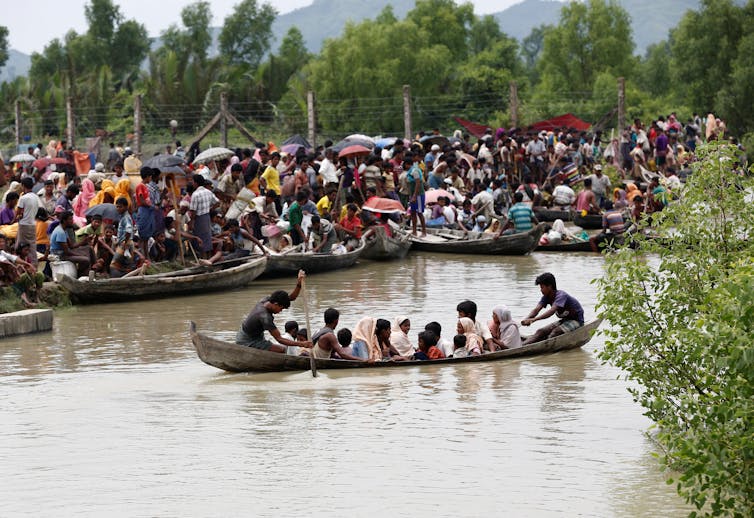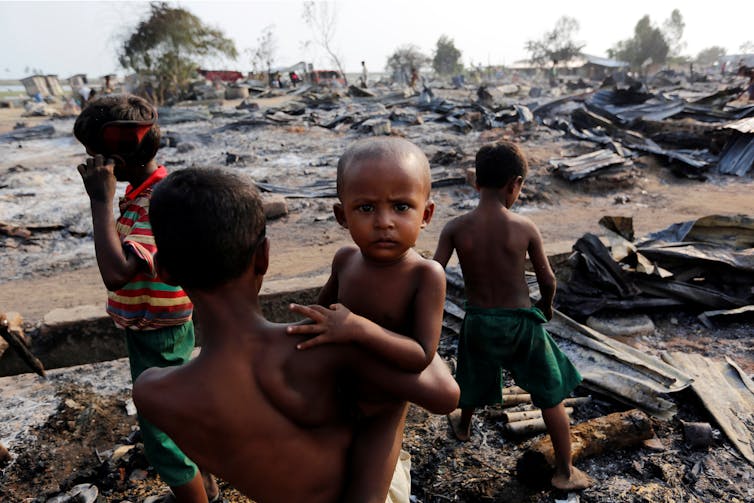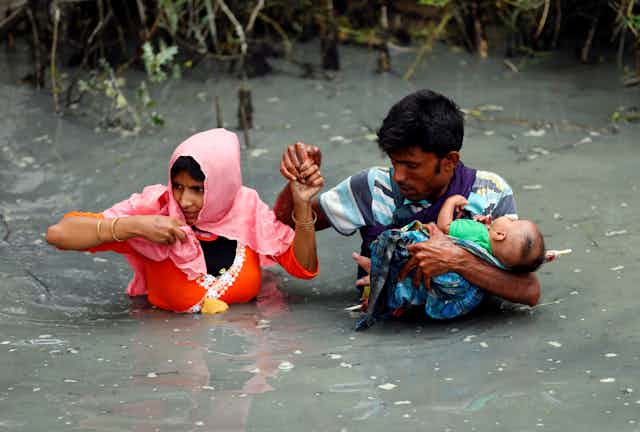A new phase of massive violent ethnic cleansing is under way in Rakhine State in western Myanmar. An estimated 160,000 men, women and children of the Muslim Rohingya community have crossed into Bangladesh, fleeing indiscriminate attacks by the armed forces.
The military crackdown was in response to a co-ordinated assault against police posts by a Rohingya militant group known as the Arakan Rohingya Salvation Army (ARSA). The militants killed 12 security personnel. In the armed forces’ “clearance operations” that followed, 400 people have died so far.
This is the latest wave of violence involving the local Buddhist Rakhine ethnic community and the Rohingya since 2012. Around 1,000 have died over this period, amid reports of mass rape and the deliberate razing of villages by the military.
About 250,000 Rohingya have fled into Bangladesh in the past five years. Others have embarked on an often deadly journey to find asylum, while many more remain in squalid detention camps within Myanmar, to which aid workers or outside observers are regularly denied access. Satellite images suggest that more than 100km of land has been burned in the recent attacks.

Survivors have recounted numerous atrocities such as beheadings and the slaughter of children. These are often acts of intimidation intended to ensure communities do not return. It seems likely that another round of violent, intentional and perhaps permanent expulsion has occurred.
History of the conflict
The causes of the turmoil are as complex as they are old. Rakhine State is the poorest region in Myanmar. Both the Muslim Rohingya and the indigenous Buddhist Rakhine community have suffered longstanding injustices at the hands of the military regime and each other.
Many Rakhine believe they lost large tracts of traditional land when the British encouraged Bengali labourers to move into Burma after assuming control in 1824. Large-scale violence between the two communities has occurred several times since the second world war.
Many Rakhine died when the Rohingya fought for Muslim-majority parts of northern Rakhine State to be integrated into East Pakistan (now Bangladesh). Subsequent military campaigns drove many Rohingya into Bangladesh: 250,000 in 1978 and a further 250,000 in 1991 and 1992, although many were forcibly repatriated to Rakhine.
Many Rakhine now seemingly support the expulsion of the group from the state, with some participating in recent military-led attacks. The ARSA attacks have dramatically worsened the already perilous position of the 1 million Rohingya left in Rakhine.
The broader political context
Also driving the contemporary violence are two broader phenomena. The first is political liberalisation since 2005; the second is a national discourse that denies the Rohingya rights as citizens of Myanmar.
A 1982 citizenship law stripped the Rohingya of the status of one of Myanmar’s “national races”, deeming them to have entered the country after 1823. This means they have no citizenship, voting rights or the right to travel. Any property they own remains vulnerable to expropriation.
Now that a partial democracy has come to Myanmar, both national and Rakhine-based political parties (such as the Rakhine Nationalities Development Party) deride the Rohingya as “Bengalis”, “interlopers” and the perpetrators of brutal crimes. This is a way of radicalising and thereby capturing the Buddhist vote.
The historical record suggests that these claims of the Rohingyas’ recent arrival in Myanmar are questionable. Many are descended from Bengali labourers who arrived after 1823, but this means they have resided in the state for almost two centuries.
And many Rohingya also lived in Rakhine before 1823. In 1799, Francis Buchanan, a visiting representative of the East India Trading Company, reported meeting “Mohammedans, who have long settled in Arakan (Rakhine), and who call themselves Rooinga, or natives of Arakan”. Many Muslims were living in Rakhine under the Kingdom of Mrauk-U between the 15th and 18th centuries.
Has the hatred become genocide?
Buddhist nationalists, in particular the Ma Ba Tha (Patriotic Association of Myanmar) led by the monk Ashin Wirathu, are promulgating much of the hatred of the Rohingya.
Despite Muslims constituting only 4% of Myanmar’s population, he and other nationalists have portrayed the Rohingya as a potentially devastating cultural and physical threat to Buddhists in Myanmar.
Wirathu’s extremism has brought him a large following and, with it, political influence. He successfully pushed a series of “race and religion” laws through parliament, including a population control bill he described as necessary to “stop the Bengalis”.

Many observers now say that recent events in Rakhine constitute genocide. The bar to this most heinous of crimes is set very high, reserved for events intended to eliminate a group in whole or in part.
The difficulty of proving intent has left many large-scale killings uncategorised as genocide. But it seems increasingly apparent that the military’s campaign against the Rohingya meets this restrictive criterion.
The repeated mass violence, the execution of civilians, destruction of villages, and atrocities designed to engender terror and effect permanent exodus, combined with the government’s ongoing denial of citizenship and other rights, all point to an intention to eliminate the Rohingya as a distinct group within Myanmar.
Using a phrase commonly used in genocides around the world, the Myanmar army chief said recently that the Bengali problem was a longstanding one which has become an unfinished job.
How can and should the international community intervene?
It is difficult to see how these waves of killings and forced expulsions will cease without international involvement.
While her supporters will say she can do little in the face of ongoing military power, government leader Aung San Suu Kyi has chosen to inflame rather than calm the situation. Her office has referred publicly to “Bengali terrorists”, claimed aid agencies are assisting Rohingya militants, stated Muslims are burning their own houses, and denied any wrongdoing by the military.
Regional and international states should intensify their pressure on the Myanmar government and the military to halt the violence and protect all civilians, whether citizens or not. ASEAN states in particular should pressure Myanmar to bring the crisis to an end.
Once this has been achieved, several measures might help reduce the frequency and intensity of the violence. The first and most important step is to grant the Rohingya naturalised citizenship and the rights that go with it. The group would then continue to live in the state, be allowed to vote and hold politicians to account.
To deflect the concerns of Rakhine, the Rohingya will need to rescind their claim to indigenous status and their ties to a traditional homeland in Rakhine. The implementation of certain electoral mechanisms – such as requirements for parties to win a portion of the votes from each community and for pairs of running mates to include a member from each group – will also slowly depoliticise ethnicity in the state.
The provision of aid, which must be rapid and substantial, must be carefully balanced so as not to cause further anger. It should be delivered to both displaced and non-displaced communities from both Rakhine and Rohingya.
None of these measures will be easy. All will face substantial resistance. But the alternative is ongoing mass killing and displacement, and further radicalisation.

